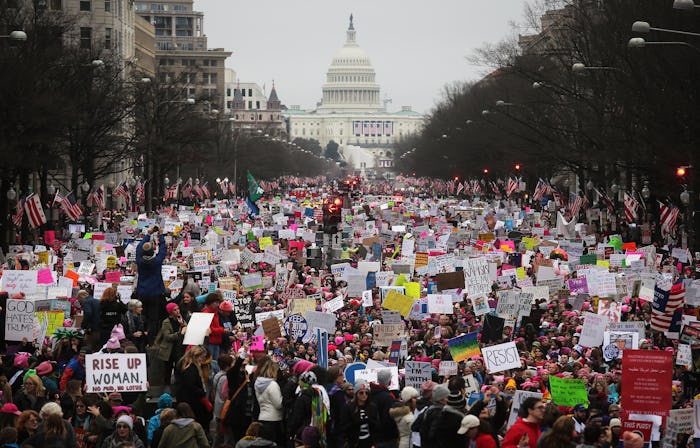News

What To Do After The Women’s March
On Saturday, as many as 2 million women gathered around the world to stand up for women's rights as human rights. At the Women's March on Washington alone, an estimated half a million people, according to the New York Times, gathered on Capitol Hill alone to tell our new president that we will be holding him accountable and that we won't stand by silently if Trump or his administration tries to pass laws that would infringe on those human rights. Millions of people have been fired up and ready to go, but it's what to do after the Women's March that matters the most. On Saturday, we sent a message. Today, the work begins.
One of the themes presented over and over again by speakers at the Women's March on Washington was the need to get to work within President Trump's first 100 days: He's certainly promised to be busy and has already shown the American people that he's no slouch, either. Trump has already reinstated the "Global gal rule," an anti-abortion policy from Reagan-era Republican politics. The Women's March just launched its 10 Actions for the first 100 Days campaign at its website: "Every 10 days we will take action on an issue we all care about, starting today."
The organization's first 100 days of action is to advise activists to send their senators a Women's March postcard: "Write a postcard to your Senators about what matters most to you - and how you’re going to continue to fight for it in the days, weeks and months ahead." You can download some rather stylish free Women's March postcards to print out and mail — or make your own. The Women's March website has been under considerable traffic since Saturday, so don't be discouraged if the website doesn't load. If its website is still being wonky, the first 10,000 people can also get a free Women's March postcard from the Ink Cards app; once the freebies run out, you can buy them for a small fee from the app.
There are many ways of participating in 100 days of resistance in the wake of the Women's March. I found Michigan filmmaker Michael Moore's Women's March speech to be incredibly inspiring, simply for his 100 days action plan alone. One of the first things he told the crowd was to learn the number for the Congressional switchboard and have them connect you to your elected officials. Speaking to the million-plus people gathered in front of the Capitol Saturday, he said:
Make this part of your new daily routine. Call Congress every single day. Every day. They have a phone number: 202-225-3121. Every day, we'll give you something to tell them.
Moore suggested that the first action for activists on Monday was to call their senators and tell them "We do not accept Betsy DeVos as our Secretary of Education." Me? I'm calling about Trump's dumb decision to withdraw the United States from the Trans-Pacific Partnership. I've made this easier for myself by looking up both the Washington, D.C. and state offices of my elected officials and added them right to my Favorites list in my phone.
Voilà! Activism in action, folks.
It doesn't matter which issue you either write on your postcard to your senator, or what you tell them on the phone. Stick to the issues that you know to the issues that matter to you most if that's easiest. One of the most important ways we can do to help keep Trump from hurting America is to act today. And tomorrow. And the next day. And to do something not just for Trump's first 100 days in office, but for the next 1,460 days he presumably has left, too.
It's time to roll up our sleeves and do the work that needs doin' — so let's get to work.